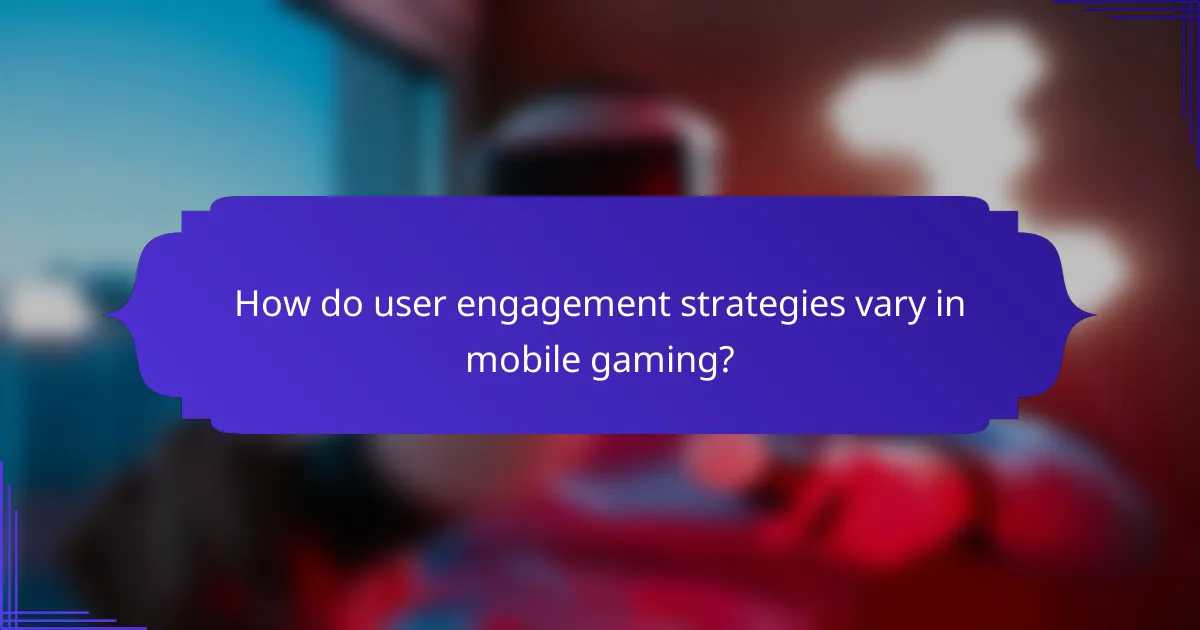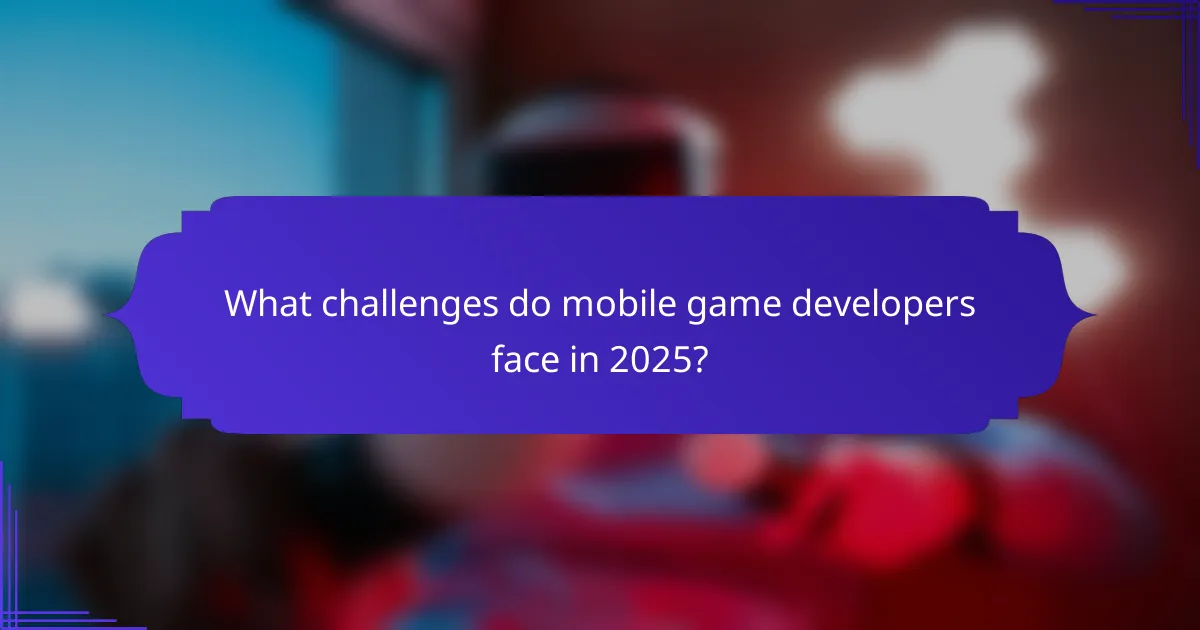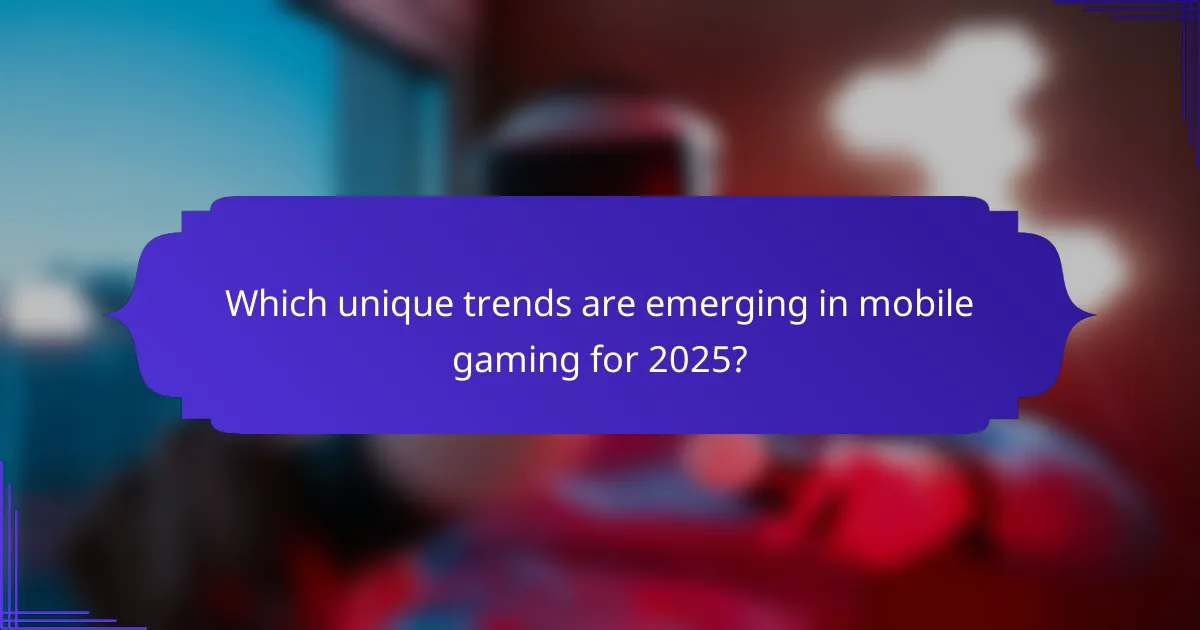Mobile gaming continues to evolve, driven by features that enhance user engagement and community interaction. Key aspects include accessibility, social connectivity, and immersive experiences. Players benefit from entertainment, cognitive improvements, and stress relief. Effective user engagement strategies such as personalised content and reward systems are essential for retention and satisfaction.

What are the key features driving mobile gaming trends?
Mobile gaming trends are driven by features such as accessibility, social connectivity, and immersive experiences. Accessibility allows players to enjoy games on various devices, increasing user engagement. Social connectivity enhances competition and collaboration among players, fostering community. Immersive experiences, including augmented reality and high-quality graphics, attract users seeking advanced gameplay. These features collectively contribute to the growing popularity of mobile gaming.
How do graphics and gameplay mechanics influence user experience?
Graphics and gameplay mechanics significantly enhance user experience by engaging players and creating immersive environments. High-quality graphics attract users, while intuitive gameplay mechanics ensure smooth interactions. Together, they foster emotional connections and prolong gameplay sessions. Engaging graphics can increase user retention by up to 30%, as players are more likely to return to visually appealing games. Effective gameplay mechanics, such as rewarding progression systems, encourage user engagement and satisfaction. Thus, both elements are crucial in shaping a positive mobile gaming experience.
Which platforms are most popular among mobile gamers?
Mobile gamers predominantly use platforms like iOS and Android. These systems dominate due to their extensive game libraries and user-friendly interfaces. iOS offers high-quality graphics and exclusive titles, while Android provides a wider range of games and customisation options. In 2023, mobile gaming revenue reached approximately $100 billion, highlighting the platforms’ popularity. User engagement strategies, such as social features and in-game events, further enhance player retention across these platforms.
What role does social interaction play in mobile gaming?
Social interaction enhances mobile gaming by fostering community engagement and collaboration among players. This interaction leads to increased user retention and satisfaction. Players often form friendships and alliances, enhancing the overall gaming experience. Additionally, social features like leaderboards and in-game chat create a competitive yet supportive environment that keeps players invested.
How is augmented reality shaping mobile gaming experiences?
Augmented reality is transforming mobile gaming by enhancing user immersion and interaction. It allows players to engage with game elements in real-world environments, creating unique experiences. This technology increases user engagement by offering dynamic gameplay and social interaction opportunities. As a result, mobile games utilising augmented reality often see higher retention rates and player satisfaction.
What are the emerging technologies enhancing mobile games?
Emerging technologies enhancing mobile games include augmented reality, cloud gaming, and artificial intelligence. These innovations improve user engagement and gameplay experiences.
Augmented reality (AR) creates immersive environments, allowing players to interact with digital elements in the real world. For instance, games like Pokémon GO utilise AR to enhance player experiences.
Cloud gaming enables high-quality graphics and processing power without needing advanced hardware. Players can access games on various devices, improving accessibility and convenience.
Artificial intelligence (AI) personalises gameplay by adapting challenges to individual player skills. This leads to increased user retention and engagement through tailored experiences.

What benefits do mobile games offer to users?
Mobile games offer users entertainment, social interaction, cognitive benefits, and stress relief. They enhance user engagement through accessible gameplay and diverse genres. Players can connect with others globally, fostering community. Additionally, mobile games improve problem-solving skills and hand-eye coordination.
How do mobile games promote cognitive skills and problem-solving?
Mobile games enhance cognitive skills and problem-solving by engaging players in complex scenarios. These games often require strategic thinking, quick decision-making, and adaptability to changing environments. For example, puzzle games challenge players to devise solutions under time constraints, promoting mental agility. As a result, regular engagement with mobile games can lead to improved memory retention and enhanced analytical skills. Studies indicate that players who frequently tackle challenging games show better problem-solving capabilities in real-life situations.
What social benefits can users gain from mobile gaming?
Mobile gaming offers significant social benefits, including enhanced social interaction and community building. Players connect with others through multiplayer experiences, fostering friendships and teamwork. These connections can lead to improved communication skills and a sense of belonging. Additionally, mobile gaming can serve as a platform for social causes, raising awareness and funds for various issues. As a result, users often experience increased social engagement and support networks.
How do mobile games serve as a source of relaxation and stress relief?
Mobile games effectively serve as a source of relaxation and stress relief by providing immersive experiences that engage users. These games often feature calming visuals and soothing soundtracks, which promote a sense of tranquility. Additionally, the interactive nature of mobile games allows players to escape from daily stressors, fostering a mental break.
Casual gaming formats, such as puzzle and simulation games, are particularly effective. They require minimal cognitive load, allowing players to unwind without intense focus. Studies indicate that playing mobile games for even short periods can significantly reduce stress levels and improve mood.
Moreover, social features in mobile games, such as multiplayer options and community interactions, enhance user engagement and provide a supportive environment. This social connection can further alleviate feelings of isolation and anxiety, contributing to overall well-being.

How do user engagement strategies vary in mobile gaming?
User engagement strategies in mobile gaming vary significantly based on player preferences and game design. Key strategies include personalised content, social features, and reward systems.
Personalised content enhances user experience through tailored recommendations and notifications. Social features, such as multiplayer modes and leaderboards, foster community interaction and competition. Reward systems, including in-game incentives and achievements, encourage continued play and investment.
As a result, these strategies adapt to evolving player expectations and technological advancements, ensuring sustained engagement and retention in mobile gaming.
What are the most effective monetization strategies for mobile games?
The most effective monetization strategies for mobile games include in-app purchases, ads, subscriptions, and premium pricing. In-app purchases allow players to buy virtual goods, enhancing their experience. Ads generate revenue through impressions and clicks, often integrated seamlessly. Subscriptions offer ongoing content or benefits for a recurring fee, fostering user loyalty. Premium pricing charges a one-time fee for full access, appealing to dedicated gamers. Each strategy can be combined for maximum revenue potential, catering to diverse player preferences.
How do game developers utilize user feedback for engagement?
Game developers utilize user feedback to enhance engagement by implementing iterative design processes. This approach allows them to adapt features based on player preferences and behaviours. Regular updates and community interactions foster a sense of involvement, encouraging players to stay engaged. Additionally, analysing feedback helps identify pain points, leading to improvements that align with user expectations. As a result, developers create a more satisfying gaming experience that retains players over time.
Which marketing tactics are most successful in attracting mobile gamers?
Effective marketing tactics for attracting mobile gamers include targeted social media advertising, influencer partnerships, and engaging in-game promotions. These strategies leverage user demographics and gaming preferences to enhance reach and engagement.
Targeted ads on platforms like Facebook and Instagram can directly reach potential players based on interests and behaviours. Influencer collaborations allow brands to tap into established gaming communities, increasing credibility and visibility. In-game promotions, such as limited-time events or exclusive rewards, encourage player participation and retention.
Utilising analytics to track user engagement and conversion rates can optimise these tactics. For instance, understanding peak times for user activity can inform ad scheduling. Overall, a combination of these methods fosters a thriving mobile gaming community.

What challenges do mobile game developers face in 2025?
Mobile game developers face significant challenges in 2025, including increased competition, evolving user expectations, and the need for innovative monetization strategies. Competition intensifies as new entrants flood the market, making user acquisition more costly. Developers must continually enhance gameplay experiences to meet rising player demands for quality and engagement. Additionally, adapting to emerging technologies, such as augmented reality and cloud gaming, requires substantial investment and expertise. Balancing user engagement with ethical monetization practices remains a rare but critical challenge, as players become more discerning about in-app purchases and advertisements.
How does competition impact the mobile gaming market?
Competition significantly drives innovation and user engagement in the mobile gaming market. It encourages developers to enhance game quality and introduce unique features. As a result, players benefit from diverse gaming experiences and improved gameplay mechanics. Competitive dynamics also lead to strategic marketing approaches, increasing user acquisition and retention rates.
What are the common pitfalls in mobile game development?
Common pitfalls in mobile game development include poor user experience, lack of market research, inadequate monetization strategies, and failure to optimize for performance. These issues can lead to decreased user engagement and retention.
1. Poor User Experience: Complicated interfaces and unclear navigation frustrate players.
2. Lack of Market Research: Ignoring player preferences can result in irrelevant game features.
3. Inadequate Monetization Strategies: Failing to balance free and paid content may alienate users.
4. Performance Optimization Failures: Slow load times and bugs can drive players away.
Addressing these pitfalls enhances player satisfaction and improves retention rates.
How do regulatory issues affect mobile gaming trends?
Regulatory issues significantly influence mobile gaming trends by shaping market access and user engagement strategies. Stricter regulations often lead to increased compliance costs, which can deter new developers. As a result, established companies may dominate the market, limiting innovation. Additionally, regulations regarding data privacy can affect user trust and engagement, leading developers to focus on creating secure gaming environments. Unique attributes, such as regional regulations, can create diverse gaming experiences across different markets, affecting global trends.

Which unique trends are emerging in mobile gaming for 2025?
Emerging trends in mobile gaming for 2025 include augmented reality integration, cloud gaming advancements, and increased focus on user-generated content. These trends enhance user engagement and create immersive experiences.
Augmented reality will allow players to interact with the real world, blending gaming with everyday environments. Cloud gaming will enable seamless access to high-quality games without the need for powerful devices. User-generated content will empower players to create and share their own game experiences, fostering community engagement.
As a result, these trends will redefine mobile gaming, making it more interactive and personalised.
How is the rise of cloud gaming influencing mobile platforms?
The rise of cloud gaming enhances mobile platforms by improving accessibility and expanding game libraries. Users can play high-quality games without needing powerful hardware, leading to increased engagement. This shift promotes cross-platform play, allowing mobile users to connect with console and PC gamers. Additionally, subscription models are evolving, offering gamers more choices and flexibility in their gaming experiences.
What role do eSports play in the future of mobile gaming?
eSports will significantly shape the future of mobile gaming by enhancing user engagement and driving technological advancements. Competitive gaming fosters community interaction and motivates developers to innovate. As mobile devices improve, eSports will likely offer immersive experiences, attracting a broader audience and increasing revenue streams. The integration of live streaming and social features will further boost participation and retention in mobile gaming ecosystems.
How are cross-platform capabilities changing user expectations?
Cross-platform capabilities are elevating user expectations by enhancing accessibility and gameplay experience. Players now anticipate seamless transitions between devices, allowing them to engage with games anytime, anywhere. This shift demands developers prioritise compatibility and performance across platforms. Improved social features, such as cross-play and shared progress, further enrich user engagement, fostering a more connected gaming community. As a result, mobile gaming is evolving to meet these higher demands, emphasising user-centric design and innovative features.

What are the best practices for maximizing user engagement in mobile games?
To maximize user engagement in mobile games, developers should implement effective strategies that enhance the gaming experience. Key practices include creating intuitive user interfaces, incorporating social features, and utilising personalised content.
Engaging gameplay mechanics, such as rewards and challenges, keep players invested. Regular updates and community interaction foster a sense of belonging. Additionally, analysing player data helps refine features and tailor experiences to user preferences.
By focusing on these strategies, mobile games can significantly improve user retention and satisfaction.
